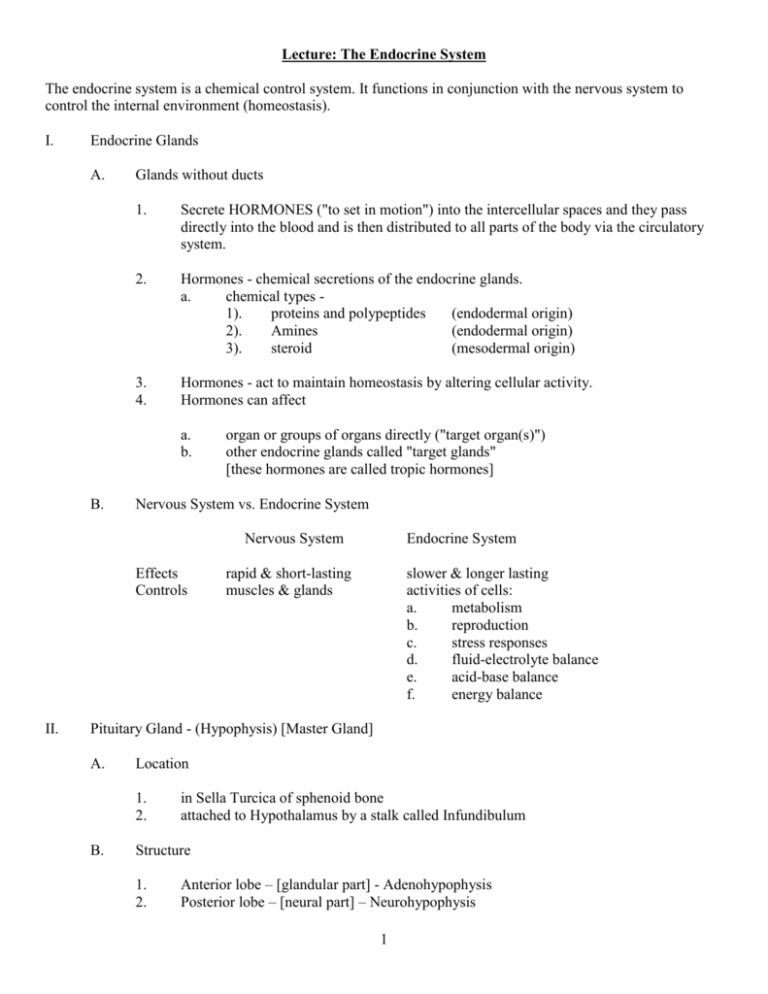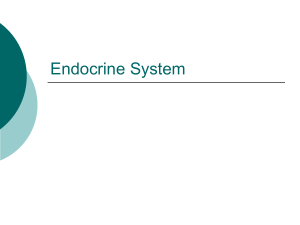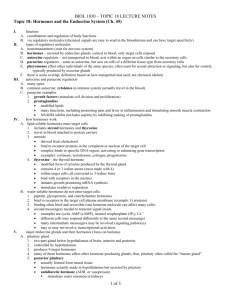Lecture: The Endocrine System
advertisement

Lecture: The Endocrine System The endocrine system is a chemical control system. It functions in conjunction with the nervous system to control the internal environment (homeostasis). I. Endocrine Glands A. Glands without ducts 1. Secrete HORMONES ("to set in motion") into the intercellular spaces and they pass directly into the blood and is then distributed to all parts of the body via the circulatory system. 2. Hormones - chemical secretions of the endocrine glands. a. chemical types 1). proteins and polypeptides (endodermal origin) 2). Amines (endodermal origin) 3). steroid (mesodermal origin) 3. 4. Hormones - act to maintain homeostasis by altering cellular activity. Hormones can affect a. b. B. organ or groups of organs directly ("target organ(s)") other endocrine glands called "target glands" [these hormones are called tropic hormones] Nervous System vs. Endocrine System Nervous System Effects Controls II. Endocrine System rapid & short-lasting muscles & glands slower & longer lasting activities of cells: a. metabolism b. reproduction c. stress responses d. fluid-electrolyte balance e. acid-base balance f. energy balance Pituitary Gland - (Hypophysis) [Master Gland] A. Location 1. 2. B. in Sella Turcica of sphenoid bone attached to Hypothalamus by a stalk called Infundibulum Structure 1. 2. Anterior lobe – [glandular part] - Adenohypophysis Posterior lobe – [neural part] – Neurohypophysis 1 C. Anterior Pituitary - (Adenohypophysis) 1. Hormone secretions controlled by secretions from the hypothalamus produced by nerve cells and control the release of hormones by Endocrine glands; these hormones are called releasing factor Growth Hormone (GH) - Somatotrophic Hormone (STH) 1. Increases Growth and Maintenance of Organs by: a. b. 2. stimulating protein anabolism promotes fat catabolism (use of fat rather than sugars for energy) Abnormal Secretions of STH a. b. c. d. Giantism -- hypersecretion during childhood (before epiphyseal plates close) Acromegaly -- hypersecretion during adulthood Dwarfism -- hyposecretion during childhood Cachexia (Simmond's Disease) - hyposecretion during adulthood causes premature aging and atrophy of organs Prolactin - (Lactogenic Hormone) 1. 2. promotes breast development during pregnancy stimulates mammary glands to produce milk after delivery Thyriod Stimulating Hormone (TSH) - (Thyrotropin) 1. 2. promotes growth of the Thyroid Gland stimulates the secretion of the Thyroid Hormone Adrenocorticotropin -- (ACTH) 1. 2. 3. promotes growth of the Adrenal Cortex stimulates the secretion of Cortical Hormones stimulates Fat Catabolism & Glycogenesis Gonadotropins - FSH and LH 1. Follicle Stimulating Hormone (FSH) a. female - stimulates the Ovarian Follicles to Develop and produce ova - stimulates the Ovarian Follicles to secrete Estrogens b. male - stimulates the production of sperm - stimulates the secretion of Testosterone 2. Luteinizing Hormone (LH) a. female - associated with FSH in development of the Ovarian Follicles - stimulates development of the Corpus Luteum following ovulation - stimulates Corpus Luteum to secrete Progesterone b. male - stimulates the Interstitial Cells to secrete Testosterone (also called Interstitial Cell Stimulating Hormone [ICSH]) 2 D. Posterior Pituitary Lobe (Neurohypophysis) 1. Antidiuretic Hormone (ADH) - produced in the hypothalamus and collected and secreted by the posterior lobe a. b. c. 2. Oxytocin a. b. III. increases the permeability of the kidney tubules to water promotes the reabsorption of the water from the urinary filtrate resulting in a smaller volume of urine Diabetes insipidus - condition resulting in larger volumes of urine produced - may be treated with vasopressin stimulates powerful contractions of the pregnant uterus at the time of delivery causes milk ejection from the lactating breast THYROID GLAND A. Location - lower aspect of larynx and upper trachea two lateral lobe connected by an isthmus on anterior surface of superior trachea B. Histology & Physiology 1. Thyroid Follicles - functional units a. follicle cells secrete Thyroxine (Thyroid Hormone) Thyroxine is a combination of Tyrosine & Iodine to make two compounds: Tetraiodothyronine - T4 Triiodothyronine - T3 Thyroxine is transported in the blood as Thyroid-binding Globulin (TBG) 2. - Test for Thyroid Activity thyroxine is transported in combination with plasma proteins (TBG) - PBI test (protein Bound Iodine) serves to quantify the levels of thyroxine in the blood 3. thyroxine Action - 4. a. Calorigenic Effects - increases Catabolism and produces extra body heat 1 mg of thyroxine = an increased heat production of 1000 calories b. Growth & Development - Works with STH to produce growth and development of tissues and organs Nervous Tissue particularly affected hyposecretion results in Mental Retardation Metabolic Effects a. b. c. diuretic protein and carbohydrate catabolism (stimulates cellular uptake) increases activity of nervous system 3 d. e. 5. Parafolliclar Cells - secrete Thyrocalcitonin (TCT) a. b. 6. increases heart rate causes muscular weakness decreases excretion of Calcium & Phosphate ions increases Osteoblast activity - Ca+2 & PO-3 deposition in bone Disorders of the Thyroid a. Hyperthyroidism (Grave's disease) - elevated PBI increases nervousness and irritability elevated BMR exophthalmos - results in edema behind the eyes b. Hypothyroidism Cretinism - occurs if the hyposecretion is during fetal or early developmental life. results in reduced metabolism results in reduced growth results in mental retardation Myxedema - occurs if the hyposecretion is during adult life results in reduced metabolism results in reduced mental & physical activity results in increased blood pressure results in accumulation of subcutaneous fluids IV. Parathyroids A. Location - 4 or 5 small round bodies on the posterior surface of the lateral lobe of the thyroid gland B. Function - secretes the Parathyroid hormone that controls Blood Calcium homeostasis C. 1. increases Ca+2 and Mg+2 absorption from the Intestines, Kidneys and Bones [raises blood calcium levels] 2. increases PO-3 excretion [lowers blood phosphate levels] Disorders of parathyroid activity 1. Hypocalcemia - causes by hyposecretion of PTH -results in Tetany [muscle spasms and convulsions] 2. Hypercalcemia - causes by hypersecretion of PTH -results in a fibrous bone disease [osteitis fibrosa cystica or also called Von Recklinghausen's Disease of the bone] 4 VI. Adrenal Glands A. Location - consists as two triangular glands and each sit like a cap on the kidneys B. Adrenal Cortex - secretes the Adrenal Cortical Hormones 1. Glucocorticoids produced by cells of the Zona Fasciculata a. b. c. - 2. Mineralocorticoids - produced by the cells of the Zona Glomerrulosa a. - 3. C. aldosterone causes Sodium retention and Potassium excretion causes water retention and blood pressure increases Gonadocorticoids - produced by cells of the Zona Reticularis a. 4. corticosterone cortisol (hydrocortisone) cortisone elevates blood sugar levels by acceleration of glycogenolysis and glucogenolysis [causes conversion of proteins into carbohydrates - resulting in "Tissue Wasting"] promotes protein catabolism promotes fat catabolism promotes vasoconstriction to maintains normal blood pressure promotes stress resistance through Anti-Inflammatory actions these are the sex hormones that are produced by the adrenal cortex in small amounts in both males and females Abnormal Adrenal Cortical Function: a. - Addison's Disease - caused by Hyposecretion of Cortical hormones results in increased blood potassium levels results decreased sodium retention and dehydration results decreased blood glucose levels results decreased blood pressure results decreased stress resistance results increased risk of kidney failure b. - Cushing's syndrome - causes by Hypersecretion of Cortical Hormones results in shifts of the body fat to the face and shoulders results in general body weakness results in altered carbohydrate & electrolyte metabolism c. - Adrenogenital Syndrome - caused by Hypersecretion of Gonadotropins results in premature sexual development in both males and females results in masculinization of females Adrenal Medulla Hormones - Epinephrine & Norepinephrine Effects: - Sympathomimetic 5 VII. Increased blood pressure due to increased heart rate & constriction of blood vessels Increased respiratory rate and dilation of bronchioles Increased blood sugar and cellular metabolism Decreased digestive tract activity Pancreas - (Islets of Langerhans cells) A. Hormones 1. - Insulin - secreted by the Beta Cells promotes lower blood glucose levels by: promoting glycogenesis, protein synthesis, and lipogenesis promoting cellular uptake 2. - Glucagon - secreted by the Alpha Cells promotes higher blood glucose by: promoting glycogenolysis 6









